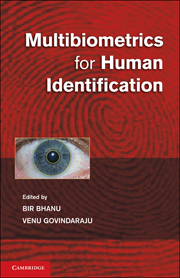Book contents
- Frontmatter
- Contents
- List of Contributors
- Preface
- Introduction
- PART I MULTIMODAL AND MULTISENSOR BIOMETRIC SYSTEMS
- 1 Multimodal Ear and Face Modeling and Recognition
- 2 Audiovisual Speech Synchrony Detection by a Family of Bimodal Linear Prediction Models
- 3 Multispectral Contact-Free Palmprint Recognition
- 4 Face Recognition under the Skin
- PART II FUSION METHODS IN MULTIBIOMETRIC SYSTEMS
- PART III HYBRID BIOMETRIC SYSTEMS
- PART IV DATABASES AND SECURITY
- PART V PERFORMANCE OF MULTIBIOMETRIC SYSTEMS
- Plate section
4 - Face Recognition under the Skin
from PART I - MULTIMODAL AND MULTISENSOR BIOMETRIC SYSTEMS
Published online by Cambridge University Press: 25 October 2011
- Frontmatter
- Contents
- List of Contributors
- Preface
- Introduction
- PART I MULTIMODAL AND MULTISENSOR BIOMETRIC SYSTEMS
- 1 Multimodal Ear and Face Modeling and Recognition
- 2 Audiovisual Speech Synchrony Detection by a Family of Bimodal Linear Prediction Models
- 3 Multispectral Contact-Free Palmprint Recognition
- 4 Face Recognition under the Skin
- PART II FUSION METHODS IN MULTIBIOMETRIC SYSTEMS
- PART III HYBRID BIOMETRIC SYSTEMS
- PART IV DATABASES AND SECURITY
- PART V PERFORMANCE OF MULTIBIOMETRIC SYSTEMS
- Plate section
Summary
Introduction
Face recognition stands as the most appealing biometric modality, since it is the natural mode of identification among humans and is totally unobtrusive. At the same time, however, it is one of the most challenging modalities (Zhao et al. 2003). Several face recognition algorithms have been developed in recent years, mostly in the visible and a few in the infrared domains. A serious problem in visible face recognition is light variability, due to the reflective nature of incident light in this band. This can clearly be seen in Figure 4.1. The visible image of the same person in Figure 4.1(a) acquired in the presence of normal light appears totally different from that in Figure 4.1(b), which was acquired in low light.
Many of the research efforts in thermal face recognition were narrowly aiming to see in the dark or reduce the deleterious effect of light variability (Figure 4.1) (Socolinsky et al. 2001; Selinger and Socolinsky 2004). Methodologically, such approaches did not differ very much from face recognition algorithms in the visible band, which can be classified as appearance-based (Chen et al. 2003) and feature-based (Buddharaju et al. 2004). Recently attempts have been made to fuse the visible and infrared modalities to increase the performance of face recognition (Socolinsky and Selinger 2004a; Wang et al. 2004; Chen et al. 2005; Kong et al. 2005).
- Type
- Chapter
- Information
- Multibiometrics for Human Identification , pp. 74 - 92Publisher: Cambridge University PressPrint publication year: 2011
- 1
- Cited by



